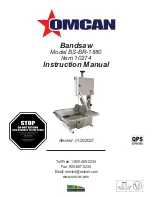
EN
15
3. Kickback causes and related warnings
Kickback is a sudden reaction of the workpiece due to a pinched, bound saw blade or
misaligned line of cut in the workpiece with respect to the saw blade or when a part of
the workpiece binds between the saw blade and the fence or other fixed object.
During kickback, in most cases, the workpiece is lifted off the table by the rear portion
of the saw blade and is propelled towards the operator.
Kickback is the result of incorrect or faulty use of the table saw. It can be prevented if
suitable precautionary measures are taken as described below.
a)
Never stand directly in line with the saw blade. Always position your body
on the same side of the saw blade as the fence rail.
Kickback may propel the
workpiece at high velocity towards anyone standing in front and in line with the
saw blade.
b)
Never reach over or in behind the saw blade to pull or support the workpiece.
Accidental contact with the saw blade may occur or kickback may drag your fingers
into the saw blade.
c)
Never hold and press the workpiece that is being cut off against the rotating
saw blade.
Pressing the workpiece being cut off against the saw blade will create
a binding condition and kickback.
d)
Align the fence rail to be parallel with the saw blade.
A misaligned fence will
pinch the workpiece against the saw blade and create kickback.
e)
Use a featherboard to guide the workpiece against the table and fence rail
when making hidden cuts (e.g. seaming).
A featherboard helps to control the
workpiece in the event of a kickback.
f)
Be particularly careful when sawing in areas of joined workpieces that you
cannot see.
The plunging saw blade can saw into objects that could cause
kickback.
g)
Support large panels to minimise the risk of blade pinching and kickback.
Large panels tend to sag under their own weight. Supports must be placed under
the panel on both sides, near the line of cut and near the edge of the panel.
h)
Use extra caution when cutting a workpiece that is twisted, knotted, warped
or does not have a straight edge to guide it with a mitre gauge or along the
fence rail.
A warped, knotted, or twisted workpiece is unstable and causes
misalignment of the kerf with the saw blade, binding and kickback.
i)
Never cut more than one workpiece, stacked vertically or horizontally.
The
saw blade could pick up one or more pieces and cause kickback.
j)
If you wish to restart a saw that is stuck in the workpiece, centre the saw
blade in the kerf and check whether that the saw teeth are not caught in the
workpiece.
If the saw blade binds, it may lift up the workpiece and cause kickback
when the saw is restarted.
k)
Keep saw blades clean, sharp, and with sufficient set. Never use warped saw
blades or saw blades with cracked or broken teeth.
Sharp and properly set saw
blades minimise binding, stalling and kickback.
4. Safety instructions for table saws
a)
Turn off the table saw and unplug it when removing the table insert, changing
















































